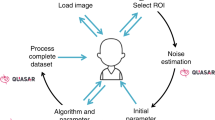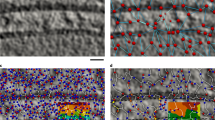Abstract
Electron Tomography (ET) is a powerful three-dimensional (3D) imaging technique used in structural biology and biomedicine to allow the visualization of the interior of cells at close-to-molecular resolution. Interpretation of the 3D volumes in ET is usually challenging due to the complexity of the cellular environment, noise conditions and other factors. Automated segmentation methods focused on membranes of the cells and organelles greatly facilitate visualization and interpretation of the 3D volumes. However, they are typically computationally expensive and spend significant processing time on standard computers. In this work, we introduce efficient implementations of one of the methods most commonly used in the ET field for membrane segmentation. They were developed by using High Performance Computing (HPC) techniques to make the most of modern CPU-based and GPU-based computing platforms. A thorough evaluation of the performance on state-of-the-art machines was carried out. The HPC implementations succeed in achieving remarkable speedups, which are around \(100\times\) on GPUs, and making it possible to process large 3D volumes in the order of seconds or a few minutes.






Similar content being viewed by others
References
Turk M, Baumeister W (2020) The promise and the challenges of cryo-electron tomography. Federation Eur Biochem Soc (FEBS) Lett 594:3243–3261
Herman GT (2009) Image reconstruction from projections: the fundamentals of computerized tomography, 2nd edn. Springer, London
Fernandez JJ (2012) Computational methods for electron tomography. Micron 43:1010–1030
Moreno JJ et al (2018) Tomoeed: Fast edge-enhancing denoising of tomographic volumes. Bioinformatics 34:3776–3778
Martinez-Sanchez A et al (2020) Template-free detection and classification of membrane-bound complexes in cryo-electron tomograms. Nat Method 17:209–216
Tasel SF et al (2016) A validated active contour method driven by parabolic arc model for detection and segmentation of mitochondria. J Struct Biol 194:253–271
Luengo I et al (2017) SuRVoS: Super-region volume segmentation workbench. J Struct Biol 198:43–53
Chen M et al (2017) Convolutional neural networks for automated annotation of cellular cryo-electron tomograms. Nat Methods 14:983–985
Li R et al (2019) Automatic localization and identification of mitochondria in cellular electron cryo-tomography using faster-RCNN. BMC Bioinformatics 20(Suppl 3):132
Fischer CA et al (2020) MitoSegNet: Easy-to-use deep learning segmentation for analyzing mitochondrial morphology. iScience 23(10):101601
Moebel E et al (2021) Deep learning improves macromolecule identification in 3D cellular cryo-electron tomograms. Nat Methods 18:1386–1394
Martinez-Sanchez A et al (2011) A differential structure approach to membrane segmentation in electron tomography. J Struct Biol 175:372–383
Martinez-Sanchez A et al (2013) A ridge-based framework for segmentation of 3D electron microscopy datasets. J Struct Biol 181:61–70
Martinez-Sanchez A et al (2014) Robust membrane detection based on tensor voting for electron tomography. J Struct Biol 186:49–61
Page C, Hanein D, Volkmann N (2015) Accurate membrane tracing in three-dimensional reconstructions from electron cryotomography data. Ultramicroscopy 155:20–26
Fernandez-Fernandez MR et al (2017) 3D electron tomography of brain tissue unveils distinct Golgi structures that sequester cytoplasmic contents in neurons. J Cell Sci 130:83–89
Chaikeeratisak V et al (2019) Viral capsid trafficking along treadmilling tubulin filaments in bacteria. Cell 177(7):1771–1780
Bäuerlein FJB et al (2017) In situ architecture and cellular interactions of polyq inclusions. Cell 171(1):179–187
Guo, Q.,. et al (2018) In situ structure of neuronal C9orf72 Poly-GA aggregates reveals proteasome recruitment. Cell 172(4):696–705
Salfer M et al (2020) Reliable estimation of membrane curvature for cryo-electron tomography. PLoS Comput Biol 16:1007962
Medioni G, Lee MS, Tang CK (2000) A Computational Framework for Segmentation and Grouping. Elsevier
Briggs JA et al (2006) The mechanism of hiv-1 core assembly: insights from three-dimensional reconstructions of authentic virions. Structure 14:15–20
Franken E et al (2006) An efficient method for tensor voting using steerable filters. Lect Notes Comput Sci 3954:228–240
Freeman WT, Adelson EH (1991) The design and use of steerable filters. IEEE Trans Pattern Anal Mach Intell 13:891–906
Frigo M, Johnson SG (2005) The design and implementation of fftw3. Proc IEEE 93:216–231
Hennessy JL, Patterson DA (2019) Computer Architecture. A Quantitative Approach, 6th edn. Morgan Kauffman Publishers, Elsevier, Cambridge, MA, USA
Fernandez JJ (2008) High performance computing in structural determination by electron cryomicroscopy. J Struct Biol 164:1–6
Tabik S et al (2007) High performance noise reduction for biomedical multidimensional data. Digit Signal Proc 17(4):724–736
Fernandez JJ, Martinez JA (2010) Three-dimensional feature-preserving noise reduction for real-time electron tomography. Digital Signal Proc 20:1162–1172
Agulleiro JI, Fernandez JJ (2011) Fast tomographic reconstruction on multicore computers. Bioinformatics 27(4):582–583
Agulleiro JI, Fernández JJ (2012) Evaluation of multicore-optimized implementation for tomographic reconstruction. PLoS ONE 7:48261
Butenhof DR (1997) Programming with POSIX Threads. Addison-Wesley Professional, Boston, MA, USA
Lawson CL et al (2016) EMDataBank unified data resource for 3DEM. Nucleic Acids Res 44:396–403
Iudin A et al (2016) EMPIAR: A public archive for raw electron microscopy image data. Nat Method 13:387–388
Bykov YS et al (2017) The structure of the copi coat determined within the cell. Elife 6:32493
Yan D et al (2019) Sphingolipid biosynthesis modulates plasmodesmal ultrastructure and phloem unloading. Nature Plants 5:604–615
Acknowledgements
This work has been supported by the projects and contracts: RTI2018-095993-B-I00, SAF2017-84565-R, PID2021-123278OB, PID2021-123424OB, TED2021-132020B (funded by MCIN/AEI/10.13039/501100011033/FEDER “A way to make Europe”); UAL18-TIC-A020020-B and P18-RT-1193 (both funded by Junta de Andalucía and FEDER); PAPI-21-GR-2011-0048 (funded by the University of Oviedo) and FUO-200-21 (funded by Thermo Fisher Scientific); and a FPU fellowship (FPU16/05946 funded by MCIN/AEI/10.13039/501100011033/ “El FSE invierte en tu futuro”) awarded to J.J. Moreno.
Author information
Authors and Affiliations
Corresponding authors
Additional information
Publisher's Note
Springer Nature remains neutral with regard to jurisdictional claims in published maps and institutional affiliations.
Rights and permissions
About this article
Cite this article
Moreno, J.J., Garzón, E.M., Fernández, J.J. et al. HPC enables efficient 3D membrane segmentation in electron tomography. J Supercomput 78, 19097–19113 (2022). https://doi.org/10.1007/s11227-022-04607-z
Accepted:
Published:
Issue Date:
DOI: https://doi.org/10.1007/s11227-022-04607-z




